For patients dealing with hearing loss, the right hearing aids can change everything. Not only will an excellent hearing loss solution restore your hearing, but it can also enable you to return to the activities you’ve always loved, engage in enjoyable conversations with friends and loved ones, and improve your overall quality of life.
Today’s hearing aid technology offers a wide range of styles, each one designed to suit specific preferences and needs. Our useful hearing aid style guide can help you learn more about how hearing aids work, the differences between hearing aid types, and how you can choose the best option for you.
How Do Hearing Aids Work?
Before discussing the types of hearing aids, it can be helpful to understand a little bit about how hearing aids work. While the specific process and operation depend largely on specific hearing devices, the basic concept remains the same. Hearing aids receive sounds through their microphones, a computer analyzes and optimizes the sounds, and then transmits the sound waves to their amplifier. After boosting the power of the sound waves, the amplifier moves them through a speaker and into the wearer’s ears.
Power is supplied to the hearing aids via batteries, with most devices using traditional button batteries. These batteries require replacement regularly, lasting between three and twenty days on average. Another option is rechargeable batteries, which have become increasingly popular.
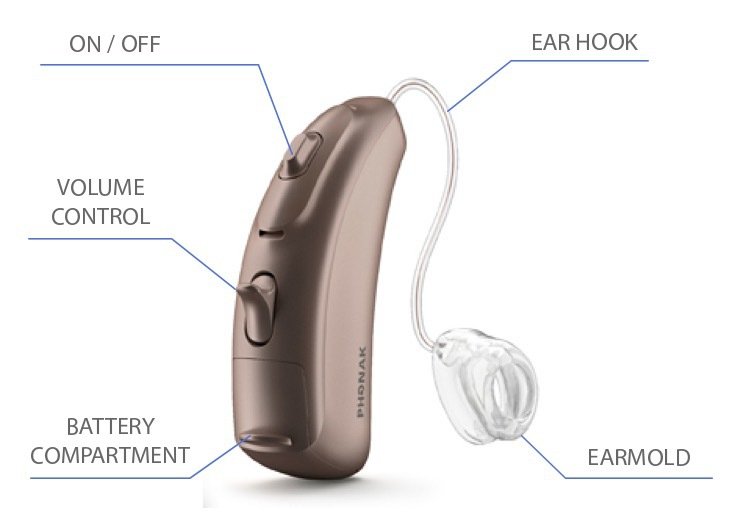
All modern hearing aids are Digital, but vary in features and technology. The majority of these feature the following components:
- Computer processor (automatic volume, noise reduction etc)
- Microphone(s)
- MSpeaker/receiver
- Amplifier(s)
- Bluetooth
- Battery
- Wax guards
In addition to the amplification and noise reduction, many hearing aids now feature wireless streaming that enables the wearer to experience streaming music, video, audio, and even phone calls transmitted directly into the hearing aid. (With compatible phones) With so many hearing aids and accessories to choose from, it is truly possible to create a highly tailored hearing solution that fits perfectly into your everyday life.
Digital Hearing Aids
Digital hearing aids have the advantage of an internal computer chip, capable of analyzing various sound waves using a programmed algorithm. This chip allows the hearing aids to distinguish between speech and other noises, then apply customized amplification. Another benefit of digital hearing aids is that they are fully programmable, so the wearer can customize the devices to suit their hearing loss (including making future adjustments as needed).
Contact us today about digital hearing aids

Types Of Hearing Aids
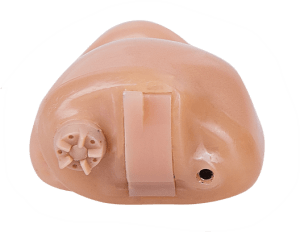
Custom Hearing Aids (ITE, ITC, CIC, IIC)
In the ear hearing aids, often referred to as ITE hearing aids, are designed to be worn inside the ear canal itself. Usually, a professional will custom fit you for this style of hearing aid, using an impression to ensure proper fit. You can find in the ear hearing aids in many different colors, allowing you to select one that blends well with the skin tone of your outer ear and make the hearing aid less noticeable. In the ear hearing aids range from very small devices that are placed deep within the ear canal to others located nearer to the outer ear.
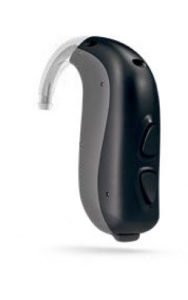
Behind the Ear (BTE) Hearing Aids
Behind the ear, or BTE, hearing aids are placed either behind or on top of the outer ear. A small tube or wire is used to route the sound from the device into the ear canal, utilizing a dome style or custom-designed earmold to avoid blocking the opening of the ear canal. Much like inside the ear hearing aids, behind the ear styles are made in a variety of colors that can be matched to hair color or skin tone for cosmetic purposes. Some wearers even choose behind the ear hearing aids printed in unique designs, expressing their personal style in a fun way.
Common Hearing Aid Styles
Continuous advancements in hearing aid technology and design have made it possible for every patient to find a style that fulfills their needs and preferences, delivering comfortable daily wear and excellent hearing restoration.
In The Ear (ITE) Styles
Invisible in the Canal (IIC)
Invisible in the canal (IIC) hearing aids are among the most discreet style, placed deep inside the ear canal so that they are virtually undetectable to the naked eye. A small pull-out string is used for removal as needed.
Usually, invisible in the canal hearing aids are recommended for patients with mild or moderate hearing loss. Because they are so small, IIC devices don’t usually feature manual controls such as program buttons or volume dials.
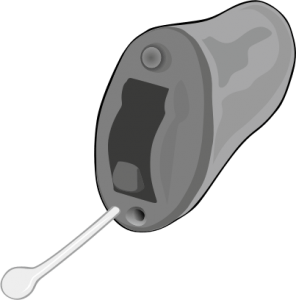
Advantages of IIC hearing aids:
- They are very discreet and essentially invisible to the people around you.
- Because they are designed to fit deep inside the ear canal, they can provide very good sound quality.
Disadvantages of IIC hearing aids:
- For patients who struggle with dexterity, the small size can be challenging to work with.
- The location of IIC hearing aids makes them more susceptible to moisture damage and ear wax buildup.
- Their size can affect the quality and consistency of connectivity to wireless devices such as smartphones.
Completely in the Canal (CIC)
Completely in the canal (CIC) hearing aids are extremely similar to invisible in the canal hearing aids, with the exception of their exact location. CIC hearing aids aren’t placed quite as deep within the ear canal, making them barely visible to the naked eye. However, just like IIC aids, they are an excellent style to consider if you prefer a very discreet style and have mild or moderate hearing loss. CIC hearing aids share the same advantages and disadvantages of IIC devices (see above).
In the Canal (ITC)
In the canal (ITC) hearing aids are larger than both CIC and IIC styles, and are designed to fit snugly in the lower part of the outer ear bowl. Their location and size make them easy to use and comfortable for everyday wear. The slightly larger size also means that they are suitable for a wider range of hearing loss when compared to CIC and IIC styles, and often have a longer battery life. ITC hearing aids may feature desirable elements such as directional microphones and easily accessible volume dials.
Advantages of ITC hearing aids:
- They are one of the more discreet styles available, less so than IIC and CIC hearing aids but still very inconspicuous.
- In comparison to the very small IIC and CIC styles, ITC hearing aids can provide more features, increased battery life, and often-easier use (especially for those with dexterity issues).
Disadvantages of ITC hearing aids:
- Because of their location, they may produce increased occlusion or be a more noticeable presence to the wearer.
- Some ITC hearing aids may struggle to provide consistent wireless connectivity due to their smaller size.
- The location makes ITC aids more likely to encounter issues due to moisture and ear wax buildup.
Full Shell/Half-Shell (FS/HS)
A full shell hearing aid design is typically custom-made to fit each specific wearer. Full shell hearing aids are large enough to offer the benefit of manual controls (such as a program button and volume wheel), as well as directional microphones that improve performance. Their size also makes low-profile devices a good match for wearers that have dexterity challenges, in contrast to the extremely small sizes of other ITE styles.
Hearing aids can range from full-shell designs to half-shell designs:
- Full-shell hearing aids fit into the outer ear bowl, filling nearly all of the available space.
- Half-shell hearing aids are designed to sit inside the outer ear bowl, taking up just half of the space.
Advantages of FS/HS hearing aids:
- Their size and shape factor into their easy maneuverability, including simple insertion and removal.
- Most low-profile devices can accommodate a wide range of hearing loss levels and offer many different features and user-operated controls.
- They are capable of connecting effectively to wireless devices, including smartphones.
Disadvantages of FS/HS hearing aids:
- Their larger size and location make them less discreet than other ITE styles.
- Wearers may experience more occlusion due to the location and size.
Behind The Ear (BTE) Styles
Receiver in Canal (RIC) or Receiver in the Ear (RITE)
Depending on the specific brand and manufacturer, this style can be called either “receiver in the ear” (RITE) or “receiver in canal” (RIC). These hearing aids incorporate an open-fit style, with the speaker included in an ear dome or earmold rather than the device’s main body. This means that the hearing aids’ speakers are located in the wearer’s ear canals, but the rest of the components (the processors and microphones) are located in a small device behind the ear itself. A thin wire connects both parts of the device and completes the “circuit.”
RIC hearing aids are generally available from all major brands because they tend to be one of the most widely recommended and highest-quality options available. The part of the device that sits behind the ear can often be customized to match hair or skin color, making them fairly discrete.
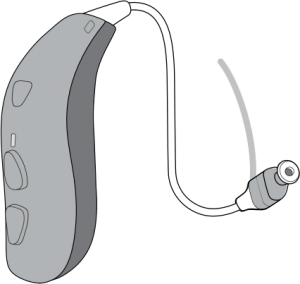
Advantages of RIC hearing aids:
- This style is very commonly offered with an option to use rechargeable batteries, which many wearers prefer for both convenience and cost-effectiveness.
- The majority of RIC styles include wireless connectivity, pairing seamlessly with smartphones and other wireless devices.
- If the speaker component is damaged or faulty, it can be replaced separately. Instead of being mailed to the manufacturer for repairs, RIC hearing aid speaker issues can often be handled directly at your local hearing aid center or audiologist.
Disadvantages of RIC hearing aids:
- Some RICs (called mini-RICs or mini-RITEs) are very small, which can be an issue for some wearers facing dexterity problems.
- Because the speaker fits inside the ear, it can fall victim to ear wax or moisture damage.
Behind the Ear with an Earmold
Behind the ear (BTE) hearing aids that utilize earmolds are among the most versatile styles available. They can provide excellent hearing restoration for a wide range of patients, from those with very mild hearing issues to those dealing with profound hearing loss.
These styles are fitted to the outer ear’s contour, tucked behind the ear and able to integrate an impressive variety of controls and features. BTE aids with earmolds also offer the longest battery life of all styles. For children and teens dealing with hearing loss, BTE hearing aids with earmold are an ideal option because they are reprogrammable, and the earmold can be switched out to accommodate the child’s growth.
Advantages of BTE hearing aids:
- They can work very well for all severities of hearing loss.
- They are custom-fitted, with an earmold that can be replaced to allow for growth.
- BTE devices with earmolds are commonly available with wireless connectivity.
- Their style makes them far less vulnerable to moisture damage.
Disadvantages of BTE hearing aids with earmolds:
- Patients who wear glasses may find they are limited in terms of space and comfortable wear.
- Their size causes more occlusion.
How Do I Choose The Right Hearing Aid For Me?
With so many different kinds of hearing aids to consider, selecting the one that’s right for you can feel like an overwhelming decision. There are many different factors to keep in mind when thinking about hearing aid types, including your budget, lifestyle, hearing loss, and cosmetic preferences.
Ultimately, the best way to find the perfect hearing aids for you is to schedule a visit with a professional audiologist. The audiologist can test your hearing to determine the specific type and severity of hearing loss, as well as recommend hearing aid options that suit your criteria.
Many people are unsure about visiting an audiologist because they wonder if the time and potential costs are unnecessary. However, purchasing your hearing aids from a professional provider will actually save you money, time, and stress in the long run. Shopping for hearing aids online or in your local drugstore nearly always ends in disappointment, with the often poorly-made hearing aids either failing to restore your hearing, constantly malfunctioning, or breaking within a short time period. Instead of dealing with the hassle of low-quality hearing aids, invest in your hearing health and happiness with a hearing loss solution that will work for you.
Schedule Your Consultation with the Best Audiologists in Arizona
At Metro Hearing, our number one priority has always been to provide each and every patient with individualized treatment and support, offering our expertise to make the hearing aid selection process as easy as possible.
With several locations throughout the Valley, Metro Hearing makes it convenient to find a hearing loss solution that can change your life for the better. Learn more about hearing aids and our team of Phoenix audiologists by contacting Metro Hearing today.
We serve the entire valley!
Check out our locations below:

